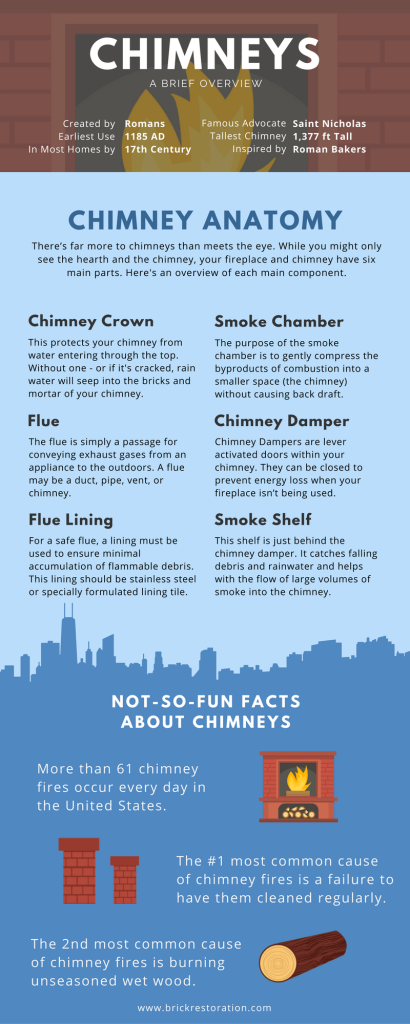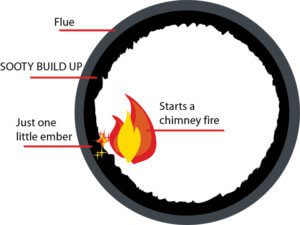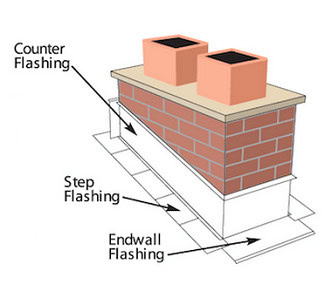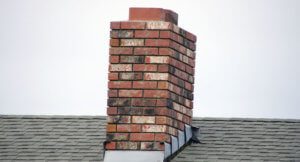The Complete Masonry Chimney Guide
With chimneys and fireplaces, repairs and maintenance are inevitable.
No matter the age or design you may have, it’s almost certain your chimney or fireplace will experience some issues that require maintenance or repairs. Even a bird’s nest in your chimney can cause you some considerable & costly problems.
The major reasons behind chimney issues will definitely vary but in this article we’ll cover their most common problems and the causes.

Masonry Chimney 101
A masonry chimney can be made up of a variety of materials including bricks & mortar, concrete, block, stone, flue tile, cast iron and steel.
These different materials can be extremely vulnerable to rainwater and other elements if not properly installed or maintained. Any external hazard can cause considerable aesthetic or physical damage to these extremely porous chimneys.
For these reason’s it’s vital to keep an eye on your chimney.
Before we dive into common repairs, here’s an infographic on the components of chimneys.

Common Chimney Issues
Now you should have a basic understanding of the different components that make up your chimney. Don’t worry if you still feel lost because we’re going to cover everything in much more detail.
Let’s dive into what can actually go wrong with your chimney and/or fireplace.

Cracks
Cracks in the crown or firebox are even considered a fire hazard by the NFPA (National Fire Protection Association). The reason is because when a chimney is being used and smoke is emitted, it carries waste particles from the fire.
This is the black smoke you see leaving a chimney when it’s in use. These waste particles build up and can get accumulated on the interior walls of the chimney and especially in any cracks there may be in the masonry.
The picture below is an example of a pretty severe buildup in a chimney flute that is a definite fire hazard.

The masonry cracks essentially become little pockets of waste particles and carbon buildup, some of which is flammable.
The real culprit is an oily substance called Creosote which is similar to soot except that it can be reignited from sparks. If there is considerable buildup of Creosote, it could be ignited by a rogue spark when the fireplace is in use.

Creosote is a flammable substance that starts off as a residue of smoke and vapors from burning wood. It clings to the venting system as it builds up as hard and flaky deposits.
For an in-depth article on Creosote, click here.
It is recommended that a chimney cleaning be performed when either soot or creosote buildup reaches ¼ inch or more.
Fire hazards are one of the biggest reasons to monitor the mortar of your chimney and fireplace for cracks. In fact, there are over 61 house fires caused by dirty chimneys per day in the United States.
If you do find some cracks in your chimney or fireplace, don’t panic.
We fix these types of fireplace cracks all of the time, however, don’t wait too long to have it repaired as the potential for damage could worsen.
Water Penetration
There are multiple entrance points for water penetration to occur and water entering the chimney can give rise to several big problems.
Aside from the usual devastation and mold that water penetration can cause, it also has another scary result.
When water mixes with the creosote it becomes acidic which, in turn, causes premature rusting of the damper and speeds up the deterioration of the brick and mortar in your chimney & fireplace.
Keep in mind that water can enter the chimney through any cracks in the crown or in the chimney shelf itself. It can also enter because of faulty flashing where the chimney meets the roof.
This water can not only cause the decaying of the exterior mortar but can also extensively damage interior walls and structural elements of your home.
All of these hazards can be avoided by keeping a regular chimney checkup schedule and ensuring that there is no room for water infiltration in any part of the chimney or fireplace.
Water repellent treatments sometimes referred to as “waterproofing” are also very effective at keeping water out of your chimney

Damaged Chimney Crown
The chimney crown is the top element of the chimney which itself acts as a shield from a number of dangers. It covers the chimney from the flue liner to the chimney edge.
The crown should have a downward slope which directs the water away from the flue edge. It must also have an overhanging drip edge which must direct the run-off from the crown away from the chimney in order to ensure that there is no erosion of the brick and mortar in the vertical surfaces of the chimney.
A proper chimney crown should be constructed in an overhanging manner of a Portland cement-based mixture and should be beyond all sides by a minimum of two inches.

Faulty Flashing
‘Flashing’ means sealing the area between the roof and the chimney which will prevent rain water or snow melt from going down into the house. It can act as a huge safeguard for the ceilings, walls and floors which would otherwise be damaged extensively every time it rained.
It’s basically an expansion joint between two dissimilar materials. It comes with the ability to allow both the roof and the chimney to expand and contract at their own rates without causing any problem to the waterproof seal.

Above is a real world example of flashing on a recent construction home that has failed and been allowing water to penetrate the house.
Improper Dimensions
Very few residential masonry contractors are actually qualified to build a masonry chimney, which means that most of them will unknowingly set you up for failure.
There are two major construction flaws that commonly cause issues for chimney owners.
- The first being the chimney might be too short to prevent downdrafts.
- The areas between the lintel and throat are not tall enough to allow the smoke to “roll” before it enters the smoke shelf.

Chimney Caps
A cap is essential for any chimney because without it the water will be pouring right into your fireplace. It will also prevent birds and squirrels from making their way into your house through the chimney opening.
It essentially keeps out debris you don’t want in your house like leaves.
Chimney Deterioration
Like any other building material, brick and mortar are subject to deterioration after exposure to the elements over a certain period of time.
The external elements gradually degrade the walls of the chimney.
If your chimney is to the point of major deterioration and is crumbling, then it is time to rebuild because the bricks and mortar have crossed their survival limit.

Leaning Chimneys
If your chimney is leaning even just slightly. Call a professional to further assess the issues, as a leaning chimney could be in danger of collapsing and causing extensive damage to your property.
Extra Resources
In conclusion, this is by no means an exhaustive list of the problems that you can encounter with your chimney or fireplace but just the most common issues that we find.
We always recommend an annual professional chimney inspection, to not only guarantee your family’s safety but to also prevent major costly repairs down the road. Remember to keep an eye out on your chimney & fireplace and visually inspect it monthly to ensure that there are no immediate issues.
A monthly 5-minute visual checkup could save you thousands in chimney and fireplace repairs.
Here’s a quick chimney & fireplace inspection checklist:
- Visually inspect the fireplace hearth for any loose bricks or cracks.
- Visually inspect the firebox to make sure it has no cracked or damaged bricks.
- Check the damper to make sure it is operational.
- Visually inspect the exterior chimney for damage or cracks.
- Repair any cracks or damage before further operation of fireplace.
We hope you found this article helpful on the common issues you may face with your chimneys and fireplaces. If you have any questions, concerns or just want to get a second opinion, don’t hesitate to reach out to us and we’ll help in anyway we can.
If you’re in the Greater Houston Area and are in need of a professional chimney inspection, we recommend Lord’s Chimney Services .
Disclaimer: Brick Restoration, Inc. is not being compensated for any referrals or recommendations made on our website. If we recommend a business, it’s because previous customers have reported a good experience.
About Brick Restoration, Inc.
We are the highest rated full-service masonry repair and installation contractor serving the Greater Houston and surrounding areas. Known for our expert workmanship and outstanding results, our extensively trained masons and patented technology separates us from other masonry contractors.
Schedule your free estimate today to meet with one of our Restoration Specialists.

My chimney has a huge crack in it. I had no idea that not cleaning my chimney could lead to it breaking. I wonder if the inside of my chimney looks like the one with all the suit in it. My wife and I will have to see if we can have someone come out this week and fix it for us.
Hey Jon, Don’t worry you are far from alone and who can blame you. It’s easy not to think about your chimney like that. Don’t hesitate to reach out for your appointment, we’re here to help!
Hello,
I like the blog. It is very useful.
Thank you for share us
Thanks so much! Glad you found it helpful.
I agree, if there are clear signs of deterioration then it is probably best to call a chimney repair service. After all, you will want to make sure that the bricks are in good shape and, if they’re not that they can be repaired. That way you chimney is always operating at peak efficiency.
Exactly! Here in Houston, our fireplaces don’t get used too often. So before the winter season starts, it’s a good idea to get an inspection to make sure its in proper working order.
My chimney brick has been flaking off for years; currently have lived there for 25 years; have a fireplace insert, and have not burned wood in this fireplace since living here; need masonry work done and would appreciate an estimate in repair cost. Thank you.
We would be happy to help with this! If you’re in Houston or the surrounding area, we can set up an appointment for a free estimate and get this work done asap for you!
EXTREMELY AWESOME POINTS YOU TOUCHED ON HERE, LOVED YOUR POST
Thank you! So glad you found it helpful.
Thanks for helping to understand my chimney better! It really helped me when talked about the crown of the chimney and how it acts as a shield. In my opinion, chimneys should be routinely cleaned and checked for erosion. My wife and I had to recently have our crown re-sealed because it had eroded too much.
So glad you found this post helpful! Let us know what other content you’d like to see!
I have what looks like aluminum molding around my chimney which is coming off more than likely due to the storms we been having. how can that be repaired
The aluminum molding is called flashing and thats a part of any chimney, it prevents water from coming in through the seems between the chimney and the roof. Typically a roofer or a chimney company would be the best people to contact for this repair.
wonderful points altogether, you just gained a logo new reader.
What might you recommend in regards to your submit
that you simply made some days in the past? Any
positive?
Thanks! we look forward to providing you with more helpful posts!
Great article! Very detailed and very very useful! Thanks for sharing!
Thanks for mentioning that if you have cracks in part of your chimney, that can be considered a fire hazard. My dad bought an older house and wants to fix it up, and one of the things he wants to restore is the chimney. I will have to tell him to make sure to have that repaired first so that he can prevent fire hazards in his home.
Thank for sharing this amazing and very useful Chimney Repairs Guide. Greeting from us at:
stone masonry vancouver
The blog post was insightful and informative. Would love to read more of this type of blogs.
We, Buffalo Grove’s Tuckpointing And Masonry, are here to help by offering our Tuckpointing services that can last for decades. Check it out, buffalogrovetuckpointing dot com
The was an insightful and informative blog about chimney repair. Common chimney issues should be checked like damaged chimney crown, faulty flashing, chimney deterioration, etc. Would love to read more of this type of blogs.
We, Buffalo Grove’s Tuckpointing And Masonry, are here to help by offering our chimney repair and rebuild services that can last for decades. Check it out, https://buffalogrovetuckpointing.com/
The was an insightful and informative blog about chimney repair. Common chimney issues should be checked like damaged chimney crown, faulty flashing, chimney deterioration, etc. Would love to read more of this type of blogs.
We, Buffalo Grove’s Tuckpointing And Masonry, are here to help by offering our chimney repair and rebuild services that can last for decades. Check it out, buffalogrovetuckpointing.com/
This was a amazing article
Great work and great job!
Thank you for pointing out that having cracks in a portion of your chimney might be a fire danger. The chimney is one of the improvements my dad wants to make to the older home he recently purchased. I’ll have to advise him to get that fixed first so he can avoid creating a fire hazard in his house.
I appreciate you letting us know that a masonry chimney is made up of a variety of materials like bricks and mortar that can be quite vulnerable to rainwater and outdoor elements if we don’t maintain it regularly or install it properly in the first place. My grandmother’s house has a masonry chimney, and since I’m spending winter there, I need to get it serviced first to avoid issues later during the coldest time of the year. I’ll take note of this while I look for a chimney services inn Colbert to hire for help soon.
Thank you for writing a post about Chimney Repair and Maintenance!
We love seeing others in the industry talking about prevention. Masters Services Chimney & Masonry is a Dallas Chimney Sweep that loves to help our neighbors with their chimney needs! https://mastersservices.com/
It’s excellent that you went into detail on whether or not chimney cracks provide a fire risk. One of the things my dad wants to refurbish is the chimney because he acquired an older house and wants to do some repairs. I’ll have to advise him to get that fixed first so he can avoid creating a fire hazard in his house.
I appreciate that you pointed out that if we don’t maintain or construct a masonry chimney correctly from the beginning, it may become highly sensitive to outside factors and rain. A masonry chimney is composed of a range of components, including bricks and mortar. Since I’ll be spending the winter at my grandmother’s house, I should get the brick chimney serviced now to prevent problems during the coldest part of the year. I’ll remember this the next time I’m looking for chimney services in Colbert, Texas, to employ.
Great post! I appreciate the detailed tips on chimney maintenance. It’s so important to keep those masonry chimneys in good shape to prevent bigger issues down the line. I’m definitely going to check for some of the signs you mentioned. Thanks for sharing!
I just like the helpful information you supply on your articles.
I will bookmark your weblog and check once more here regularly.
I am reasonably certain I will be told many new stuff
right here! Good luck for the following!
Its like you read my mind! You seem to know
a lot about this, like you wrote the book in it or something.
I think that you can do with some pics to drive the message
home a bit, but other than that, this is excellent blog. A fantastic read.
I’ll definitely be back.
Great tips in this post! I never realized how important regular maintenance is for chimney longevity. I’m definitely going to check for cracks and get some waterproofing done before winter. Thanks for the insights!
Cracks in chimneys can lead to creosote buildup, fire hazards, and structural damage. Regular inspections and timely repairs are essential to avoid costly issues and ensure safety.
Admiring the persistence you put into your site and detailed
information you provide. It’s awesome to come across a
blog every once in a while that isn’t the same outdated rehashed information. Wonderful read!
I’ve saved your site and I’m adding your RSS feeds
to my Google account.
Do you have any video of that? I’d want to find out some additional information.
It’s a pity you don’t have a donate button! I’d definitely donate to this fantastic blog!
I guess for now i’ll settle for book-marking and adding
your RSS feed to my Google account. I look forward
to fresh updates and will talk about this website with my
Facebook group. Chat soon!
This post is incredibly helpful! I had no idea about the importance of regular inspections and maintenance for my masonry chimney. The tips on identifying common issues and the step-by-step approach to repairs make it seem much more manageable. Thanks for sharing such valuable information!
Your way of describing the whole thing in this post is really pleasant, all
be able to simply know it, Thanks a lot.
Hello mates, its enormous article on the topic
of teachingand completely explained, keep it up all the time.
This post was incredibly helpful! I had no idea the importance of regular maintenance for my masonry chimney. The tips on identifying common issues and the step-by-step guide for repairs really gave me the confidence to tackle this project. Thanks for sharing such valuable information!
Excellent overview! This post breaks down chimney repairs in a way that’s easy to understand—very helpful for homeowners looking to stay ahead of costly damage. Thanks for the insights.
My relatives every time say that I am killing my time here at web, however I know I am
getting familiarity all the time by reading thes good articles
or reviews.
Great tips! I had no idea that regular maintenance could prolong the life of my chimney so much. The step-by-step guide on brick restoration was particularly helpful. I’ll definitely be putting these suggestions into practice. Thanks for sharing!
Great tips! I didn’t realize how important regular maintenance was for chimney longevity. The step-by-step guide on brick restoration is particularly helpful. I’ll definitely be checking my chimney before winter! Thank you, Brick Restoration, Inc.!
Great read. The breakdown of common chimney issues and repair tips is super informative. It’s a valuable resource for homeowners looking to maintain chimney safety and function.
This post was incredibly helpful! I learned so much about the importance of regular maintenance for my masonry chimney. The tips on identifying common issues like cracks and moisture damage are especially useful. I appreciate the focus on preventive measures too—definitely going to schedule a professional inspection soon! Thank you for sharing this valuable information!
Great tips! I never realized how important regular maintenance is for keeping my chimney in good shape. The section on identifying common issues was particularly helpful. Thanks for sharing your expertise!
Great tips! I didn’t realize how crucial it is to regularly inspect the masonry for signs of wear. I’ll definitely be more proactive with my chimney maintenance after reading this. Thank you for the helpful advice!
Great tips! I had no idea about the importance of regular inspections. I’ll definitely be checking my chimney for cracks and considering routine maintenance to avoid larger issues down the line. Thanks for the helpful information!
Great tips in this post! I never realized how important regular maintenance is for my chimney. The step-by-step guide on identifying issues was particularly helpful. I’ll definitely be checking for cracks and scheduling some repairs soon. Thanks for the insights!
Great tips! I had no idea that regular inspection could prevent so many issues. I’ll definitely be checking my chimney more frequently after reading this. Thanks for the valuable information!